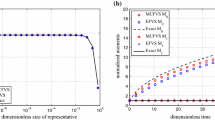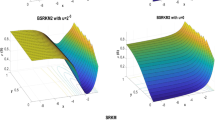Abstract
In this work we study the convergence of the fixed pivot techniques (Kumar and Ramkrishna Chem. Eng. Sci. 51, 1311–1332, 1996) for breakage problems. In particular, the convergence is investigated on four different types of uniform and non-uniform meshes. It is shown that the fixed pivot technique is second order convergent on a uniform and non-uniform smooth meshes. Furthermore, it gives first order convergence on a locally uniform mesh. Finally the analysis shows that the method does not converge on a non-uniform random mesh. The mathematical results of convergence analysis are also validated numerically.
Similar content being viewed by others
References
Ball J.M., Carr J.: The discrete coagulation-fragmentation equations: Existence, uniqueness, and density conservation. J. Stat. Phys. 61, 203–234 (1990)
Costa F.P.D.: A finite-dimensional dynamical model for gelation in coagulation processes. J. Nonlin. Sci. 8, 619–653 (1998)
Dubovskǐ P.B., Galkin V.A., Stewart I.W.: Exact solutions for the coagulation-fragmentation equations. J. Phys. A Math. Gen. 25, 4737–4744 (1992)
Dubovskǐ P.B., Stewart I.W.: Existence, uniqueness and mass conservation for the coagulation-fragmentation equation. Math. Meth. Appl. Sci. 19, 571–591 (1996)
Everson R.C., Eyre D., Campbell Q.P.: Spline method for solving continuous batch grinding and similarity equations. Comput. Chem. Eng. 21, 1433–1440 (1997)
Filbet F., Laurençot P.: Mass-conserving solutions and non-conservative approximation to the smoluchowski coagulation equation. Archiv der Mathematik 83, 558–567 (2004)
Hill P.J., Ng K.M.: New discretization procedure for the breakage equation. AIChE J. 41, 1204–1216 (1995)
Hundsdorfer W., Verwer J.G.: Numerical solution of time-dependent advection–diffusion-reaction equations, 1st edn. Springer, New York (2003)
Kostoglou M., Karabelas A.J.: An assessment of low-order methods for solving the breakage equation. Powder Technol. 127, 116–127 (2002)
Kostoglou M., Karabelas A.J.: Optimal low order methods of moments for solving the fragmentation equation. Powder Technol. 143(144), 280–290 (2004)
Kostoglou M., Karabelas A.J.: On the self similar solution of fragmentation equation: Numerical evaluation with implication for the inverse problem. J. Colloid Interface Sci. 284, 571–581 (2005)
Kumar J., Peglow M., Warnecke G., Heinrich S.: An efficient numerical technique for solving population balance equation involving aggregation, breakage, growth and nucleation. Powder Technol. 179, 205–228 (2007)
Kumar J., Peglow M., Warnecke G., Heinrich S., Mörl L.: Improved accuracy and convergence of discretized population balance for aggregation: the cell average technique. Chem. Eng. Sci. 61, 3327–3342 (2006)
Kumar, J., Warnecke, G.: Convergence analysis of sectional methods for solving breakage population balance equation-II. The cell average technique. Accepted for publication in Numerische Mathematik (2008)
Kumar, J., Warnecke, G., Peglow, M., Heinrich, S.: Comparison of numerical methods for solving population balance equations incorporating aggregation and breakage. Powder Technol. (in press, 2008)
Kumar S., Ramkrishna D.: On the solution of population balance equations by discretization-I. A fixed pivot technique. Chem. Eng. Sci. 51, 1311–1332 (1996)
Kumar S., Ramkrishna D.: On the solution of population balance equations by discretization-II. A moving pivot technique. Chem. Eng. Sci. 51, 1333–1342 (1996)
Lamb W.: Existence and uniqueness results for the continuous coagulation and fragmentation equation. Math. Meth. Appl. Sci. 27, 703–721 (2004)
Laurençot P.: On a class of continuous coagulation–fragmentation equations. J. Diff. Eq. 167, 245–274 (2000)
Lee M.H.: On the validity of the coagulation equation and the nature of runaway growth. Icarus 143, 74–86 (2000)
McLaughlin D.J., Lamb W., McBride A.C.: An existence and uniqueness result for a coagulation and multiple-fragmentation equation. SIAM J. Math. Anal. 28, 1173–1190 (1997)
McLaughlin D.J., Lamb W., McBride A.C.: Existence and uniqueness results for the non-autonomous coagulation and multiple-fragmentation equation. Math. Meth. Appl. Sci. 21, 1067–1084 (1998)
Mishra B.K.: Monte Carlo simulation of particle breakage process during grinding. Powder Technol. 110, 246–252 (2000)
Press, W.H., Teukolsky, S.A., Vetterling, W.T., Flannery, B.P.: Numerical recipes in C++, 2nd edn. Cambridge University Press, The Edinburgh Building, Cambridge (2002)
Vanni M.: Discretization procedure for the breakage equation. AIChE J. 45, 916–919 (1999)
Vanni M.: Approximate population balance equations for aggregation-breakage processes. J. Collid Interface Sci. 221, 143–160 (2002)
Ziff R.M.: New solution to the fragmentation equation. J. Phys. A Math. Gen. 24, 2821–2828 (1991)
Ziff R.M., McGrady E.D.: The kinetics of cluster fragmentation and depolymerization. J. Phys. A Math. Gen. 18, 3027–3037 (1985)
Author information
Authors and Affiliations
Corresponding author
Rights and permissions
About this article
Cite this article
Kumar, J., Warnecke, G. Convergence analysis of sectional methods for solving breakage population balance equations-I: the fixed pivot technique. Numer. Math. 111, 81–108 (2008). https://doi.org/10.1007/s00211-008-0174-6
Received:
Revised:
Published:
Issue Date:
DOI: https://doi.org/10.1007/s00211-008-0174-6




